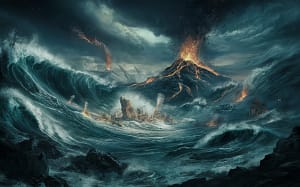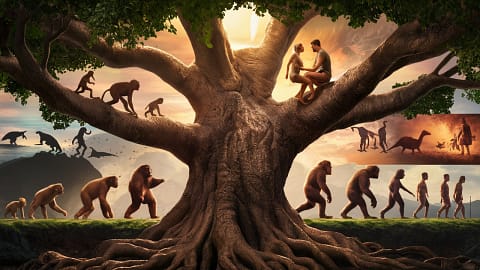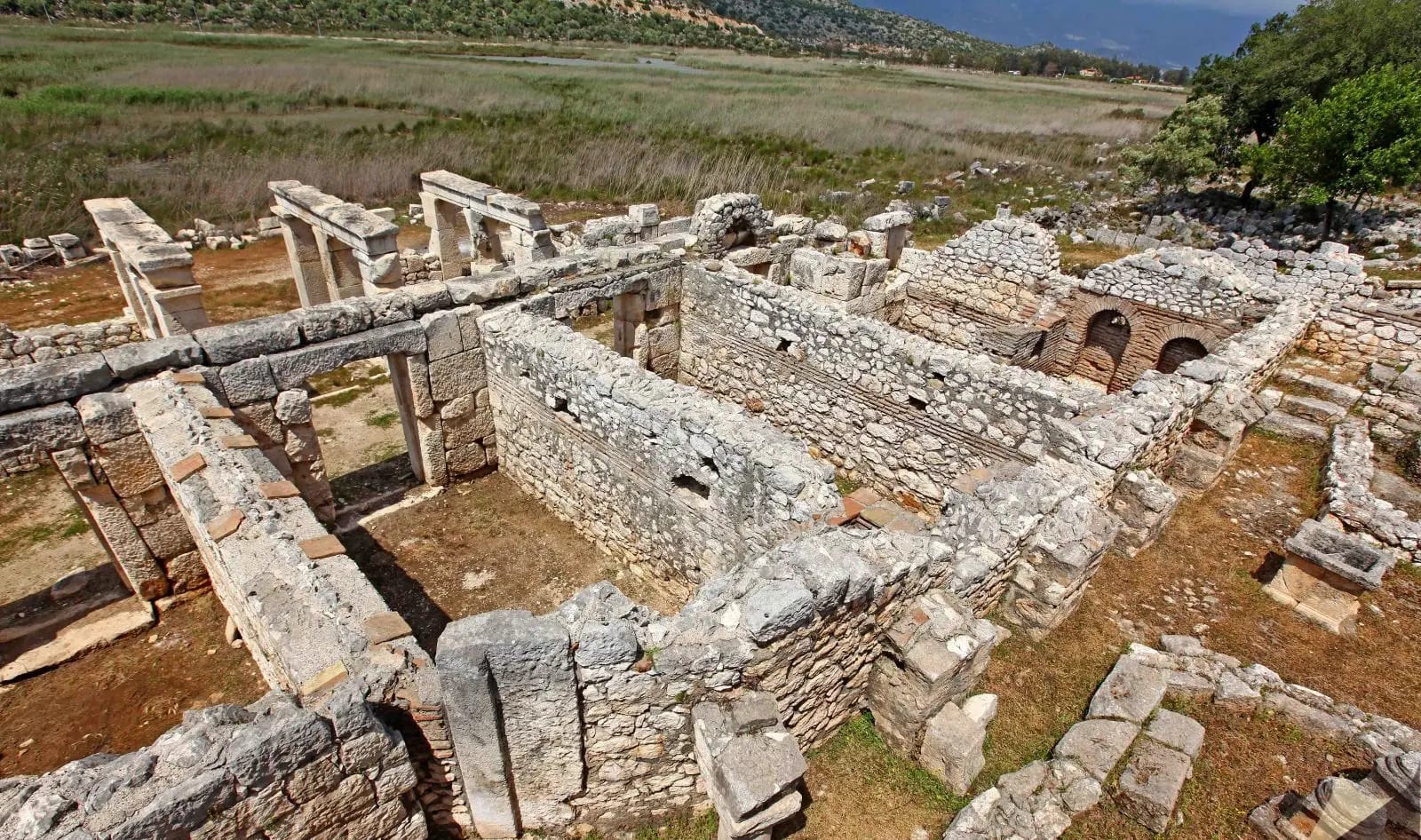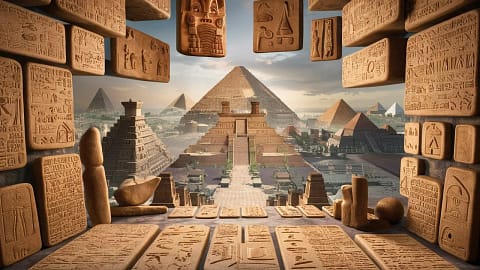The Mu Continent: Myth or Reality? In the Footsteps of Lost Civilizations
The Origin of the Myth: Echoes of a Lost Paradise

The myth of the Mu continent gained popularity through the works of Augustus Le Plongeon, a 19th-century writer and explorer. During his research on the ruins of the Mayan civilization, Le Plongeon came to believe that their origins lay in an ancient continent submerged in the Pacific Ocean. He named this lost continent "Mu" and suggested that this civilization was also a source of inspiration for Egypt and other ancient cultures. 1
However, the roots of the Mu myth go back much further than Le Plongeon. Many cultures around the world have similar myths about lost continents or civilizations submerged due to great floods or disasters. For example, the myth of Atlantis in Greek mythology, the myth of Kumari Kandam in Hinduism, and the myth of Ys in Celtic mythology bear similarities to the Mu continent. 2
The common point of these myths is that these societies, which generally had an advanced civilization, were punished and destroyed because of their arrogance or defiance of the gods. These themes carry a deep archetypal meaning about humanity's ancient past and helplessness in the face of nature. The Mu myth also exemplifies these universal themes.
Although Le Plongeon's work introduced the Mu myth to the modern world, the origin of the myth has a much older and more complex structure. Similar myths in different cultures may point to a common past or collective unconscious of humanity. As a reflection of this collective unconscious, the Mu myth represents humanity's yearning for a lost paradise and admiration for the glorious civilizations of the past.
Augustus Le Plongeon and James Churchward: Passionate Advocates of the Mu Continent
Augustus Le Plongeon (1826-1908) and James Churchward (1851-1936) are two important figures who introduced and popularized the Mu myth to the modern world. Both were considered controversial and unusual figures in their time.
Augustus Le Plongeon
A French-American photographer, antiquarian, and amateur archaeologist, Le Plongeon is known for his work on the Mayan civilization in the mid-19th century. His excavations and photographs at important Mayan cities such as Uxmal and Chichen Itza in Mexico's Yucatán Peninsula aroused great interest in Mayan culture. 3
Le Plongeon attempted to decipher Mayan hieroglyphs and developed the Mu continent myth based on his own interpretations. According to him, the Mayans were descendants of immigrants from the Mu continent, and this ancient civilization was also a source of inspiration for Egypt and other ancient cultures. Although Le Plongeon's claims were largely rejected by scientists of the time, they played an important role in the spread of the Mu continent myth. 4
James Churchward
A British-American writer, explorer, and engineer, Churchward brought the Mu myth to even wider audiences in the early 20th century. He claimed to have found hidden tablets in an ancient temple while serving in the military in India, and that these tablets contained information about the history of the Mu continent. 5
Churchward described the Mu continent as a massive landmass in the Pacific Ocean and claimed that this civilization existed 50,000 years ago. According to him, Mu was the cradle of all humanity, and people who migrated from here to different parts of the world established different civilizations. Although Churchward's claims were not accepted by scientific circles, his books and lectures made the Mu myth a part of popular culture. 6
The work of Le Plongeon and Churchward played a major role in the Mu myth gaining its current popularity. Although not supported by scientific evidence, the passionate advocacy of these two researchers has ensured that the Mu myth remains an intriguing and mysterious topic.

Features: The Splendor of Lost Paradise
Mu legends depict the fascinating features of this lost civilization in various ways. The stories about its geographical location, climate, culture, technology, and people resemble a utopia.
Geographical Location: The Mu continent is believed to have covered a vast area in the middle of the Pacific Ocean, among the present-day Hawaiian Islands, Easter Island, and other Polynesian islands. Some sources state that the continent served as a bridge between the continents of Asia and America. 5
Climate: The climate of the Mu continent is described as mild and sunny throughout the year. With its fertile soil, lush forests, and clear waters, it is said to resemble a paradise garden. 7
Culture: The Mu civilization is described as having a high cultural and spiritual development. It is stated that they reached an advanced level in the fields of art, science, philosophy, and religion. They are said to be particularly skilled in architecture and to have built magnificent temples, palaces, and monuments. 8
Technology: The Mu civilization is claimed to have knowledge and technology that surpasses even today's technology. They are described as having extraordinary abilities such as flying machines, energy crystals, telepathy, and levitation. It is also said that they could predict and control natural disasters such as earthquakes and volcanic eruptions. 9
People: The inhabitants of the Mu continent are described as physically beautiful, tall, and blond-haired. They are said to be peaceful, wise, and spiritually developed. It is also described that all people were equal and had a classless and fair social structure. 10
This information about the features of the Mu continent is, of course, not supported by scientific evidence. However, these legends offer important clues about humanity's ancient past and the dream of an ideal civilization. Even if it is a utopia that never existed, it keeps alive the belief in humanity's potential to create a better world.
The Sinking of Mu Continent:

It is one of the most dramatic and mysterious aspects of the legend. Different sources and researchers have put forward various theories about the causes of this event.
1. Natural Disasters:
- Volcanic Eruptions and Earthquakes: The most common theory is that the Mu continent sank as a result of violent volcanic eruptions and earthquakes. According to this theory, the massive volcanoes under the continent became active and caused large lava flows, earthquakes, and tsunamis. As a result of these disasters, the continent sank into the depths of the ocean with a great noise. 5
- Pole Shift: Some researchers suggest that the sinking of the Mu continent occurred as a result of the shifting of the Earth's magnetic poles. According to this theory, the pole shift disrupted the balance of the continent and caused a major collapse. 11
2. Divine Wrath:
- Punishment of the Gods: Another theory is that the Mu civilization was subjected to the wrath of the gods and punished for their arrogant and immoral behavior. According to this theory, the gods destroyed the Mu continent with a great flood or rain of fire. 12
3. War and Internal Conflicts:
- Technological War: Some sources suggest that the Mu civilization misused its advanced technology, leading to internal conflicts and a devastating war. According to this theory, they perished with the weapons they created themselves. 13
4. Other Theories:
- Alien Intervention: Some conspiracy theories claim that the sinking of the Mu continent occurred as a result of the intervention of extraterrestrial beings.
- Time Cycle: Some esoteric sources suggest that the sinking of the Mu continent was the end of a certain time cycle of the Earth and that this event could be repeated.
The real reason for the sinking of the Mu continent is still unknown. However, these theories help us ask important questions about humanity's past and future and consider different possibilities. The Mu legend may one day be illuminated by scientific research and reveal its true face.

Other Legends Related to the Continent of Mu: Hidden Connections Between Lost Continents
The legend of Mu is not alone. There are similar legends of lost continents in different cultures and geographies around the world. The most well-known of these are Atlantis and Lemuria. There are intriguing parallels and possible connections between these legends.
Atlantis: The legend of Atlantis, recounted by the Greek philosopher Plato, tells of an advanced civilization thought to have existed in the Atlantic Ocean around 9000 BC. The Atlanteans are depicted as having advanced technology, a rich culture, and a powerful navy. However, due to their arrogance and defiance of the gods, they were submerged and destroyed in a single night. 14
Lemuria: Lemuria (or Mu), believed to be located in the Indian Ocean, is a legend that emerged in the 19th century. Based on some geological similarities between Madagascar and India, this legend has been enriched with mystical and esoteric elements over time. Like Mu, Lemuria is thought to have been home to an advanced civilization and to have sunk due to natural disasters. 15
Connections Between Mu, Atlantis, and Lemuria:
- Geographical Location: Although all three continents are located in different oceans, some researchers suggest that these continents may have been connected or different parts of the same continent. According to this theory, the continents broke apart as a result of sinking, leading to the emergence of new civilizations in different regions. 16
- Technology and Culture: All three civilizations are said to have possessed advanced technology, rich culture, and spiritual wisdom. These similarities suggest the possibility of interaction or a common origin between these civilizations. 17
- Reasons for Sinking: All three continents are thought to have sunk due to natural disasters or divine wrath. This commonality suggests that these legends may have been created to emphasize humanity's helplessness in the face of nature and the consequences of arrogance. 18
These connections between the legends of Mu, Atlantis, and Lemuria are cited by some researchers as evidence for the existence of a common "lost civilization." However, these claims have not yet been scientifically proven. Nevertheless, these legends offer important clues about humanity's ancient past and universal archetypes.
Mu's Place in Popular Culture: The Magical Allure of the Mu Continent
The legend of the Mu continent, with its mysterious and exotic atmosphere, has been a source of inspiration for artists, writers, and filmmakers for centuries. Appearing in books, movies, TV series, and even video games, Mu has carved out a significant place in popular culture.
Mu in Literature:
- The Lost Continent of Mu (1926): This work by James Churchward is one of the most important books that introduced and popularized the Mu legend to the modern world. In his book, Churchward describes the history, culture, and technology of the Mu civilization in detail, taking readers on a magical journey.
- The Story of Atlantis & the Lost Lemuria (1904): This book by William Scott-Elliot comparatively examines the legends of Mu (Lemuria) and Atlantis. Scott-Elliot argues that both civilizations had high spiritual and technological advancement and were destroyed by natural disasters.
- Mu: The Motherland (1931): Another important work by Churchward, this book examines the connections and influence of the Mu continent with other civilizations around the world. Churchward suggests that Mu was a significant force that shaped human history.
Mu in Film and Television:
- Mu (1978): Directed by Japanese filmmaker Masahiro Shinoda, this film depicts the sinking of the Mu continent and the survivors spreading to different parts of the world to establish new civilizations. The film is notable for its visual effects and fantastical atmosphere.
- Stargate SG-1 (1997-2007): In this popular science fiction series, an ancient race known as the Ancients is said to have migrated from the Mu continent to Earth and established an advanced civilization there. In the series, the Ancients' technology and knowledge are discovered by modern humans and used to unravel the secrets of the universe.
- The Venture Bros. (2003-2018): In this animated series, Mu is depicted as a place where secret organizations and superheroes battle. In the series, the descendants of those who survived the sinking of the Mu continent still exist today.
Mu in Video Games:
- Megami Tensei II (1990): In this Japanese role-playing game, Mu is depicted as a place where demons and gods battle. Players travel through the ruins of the Mu continent, fighting demons and trying to save the world.
- Uncharted 2: Among Thieves (2009): In this action-adventure game, Mu appears as a mysterious place where lost treasures are hidden. Players complete challenging tasks to reach the ruins of the Mu continent and seize the treasures.
With these diverse reflections in popular culture, the Mu legend continues to keep humanity's imagination and curiosity alive. Although not scientifically proven, Mu remains a powerful symbol that fuels our curiosity about lost civilizations and the origins of humanity.
Scientific Research and Findings: The Scientific Scrutiny of the Mu Continent
Scientific research on the existence of the Mu continent has been carried out in various disciplines from the 19th century to the present day. Studies in geology, archaeology, oceanography, and other related fields have questioned the reality of Mu, and scientists have put forward different views in light of the findings.
Geological Research:
- Plate Tectonics: The theory of plate tectonics explains that the Earth's crust consists of plates that are in constant motion and that the continents are shaped by the interactions of these plates. According to this theory, it is geologically impossible for a landmass the size of the Mu continent to sink in the Pacific Ocean. The traces of such an event should be clearly visible on the ocean floor and surrounding continents. 19
- Ocean Floor Research: Ocean floor research using sonar technology has not found any remnants of the Mu continent in the Pacific Ocean. On the contrary, the ocean floor consists of volcanic mountains, ridges, and trenches that have formed slowly over millions of years. 20
Archaeological Research:
- Polynesian Civilizations: Archaeological excavations in the Polynesian islands show that the origins of the civilizations in this region are based on migrations from Southeast Asia, not the Mu continent. Linguistic and genetic studies also support these findings. 21
- Maya Civilization: Research on the Maya civilization reveals that their origins developed in Central America and have no direct connection to the Mu continent. The Maya language and culture are seen to share similarities with other Mesoamerican civilizations. 22
Scientists' Views:
- Skeptical Approach: Most scientists believe that there is no scientific evidence for the existence of the Mu continent. Geological and archaeological findings do not support the Mu legend. Therefore, the Mu continent is generally considered a legend or myth.
- Alternative Explanations: Some researchers believe that the Mu legend may be based on a real event or place. For example, some suggest that the Mu continent could be a small island that was destroyed by volcanic eruptions, such as Easter Island. Others believe that the Mu legend reflects a common "lost paradise" archetype in different cultures.
Scientific research on the existence of the Mu continent continues. However, the findings so far do not support the reality of the Mu continent. Nevertheless, this legend helps us to ask important questions about humanity's past and imagination and to consider different possibilities.
A Critical Look: Is Mu Continent Real, or Just a Myth?
The legend of the Mu continent has captivated the human imagination for centuries, remaining shrouded in mystery. While some believe this legend is based on a real foundation, others reject these claims due to the lack of scientific evidence.
The Mu Continent through the Eyes of Believers:
Those who believe in the Mu continent argue that this legend isn't just a myth but tells the story of the existence and disappearance of a real civilization. According to them, Mu is an important part of human history, and the legacy of this civilization still leaves its mark on today's cultures.
- Esoteric and Spiritual Beliefs: Some esoteric and spiritual groups view the Mu continent as the spiritual origin of humanity. They believe the Mu civilization reached a high level of consciousness and discovered the secrets of the universe. These groups interpret the sinking of Mu as a symbol of humanity's spiritual decline. 23
- Alternative History Theories: Some researchers criticize the official understanding of history, which doesn't accept the existence of Mu. They believe that lost civilizations like Mu could reveal unknown or hidden aspects of human history. These researchers think that evidence for Mu's existence is hidden among archaeological findings and ancient texts that cannot be explained by traditional scientific methods. 24
The Mu Continent through the Eyes of Skeptics:
Those who approach the Mu continent with skepticism argue that this legend is not supported by scientific evidence and contradicts geological and archaeological facts. They believe that Mu is merely a myth or a figment of the imagination.
- Lack of Scientific Evidence: There is no concrete evidence for the existence of Mu. Geological research has not found any traces in the Pacific Ocean to suggest that such a continent could have sunk. Archaeological findings also do not confirm the authenticity of structures or artifacts claimed to belong to the Mu civilization. 25
- Origin of the Legend: The Mu continent legend gained popularity with the works of researchers like Augustus Le Plongeon and James Churchward in the 19th century. However, the methods and claims of these researchers are criticized by the scientific community. Therefore, the credibility of the Mu continent legend is questioned.
Conclusion
The Mu continent legend remains a controversial topic. Believers and skeptics present different arguments to defend their perspectives. However, it is a fact that no scientific evidence has been found to support the existence of Mu. Therefore, it's important to approach the Mu continent legend with a critical eye and evaluate the views of both believers and skeptics. Perhaps one day, new scientific discoveries will shed light on this mystery and reveal the true face of the Mu continent.
Sources:
Sources:
- Churchward, J. (2007). The Lost Continent of Mu. Adventures Unlimited Press.[↩]
- Hancock, G. (2012). Fingerprints of the Gods: The Evidence of Earth’s Lost Civilization. Crown.[↩]
- Le Plongeon, A. (1999). A Fall from Archaeological Grace. Assembling the Past: Studies in the Professionalization of Archaeology, 81.[↩]
- Childress, D. H. (1988). Lost cities of ancient Lemuria & the Pacific. (No Title).[↩]
- Churchward, J. (2007). The Lost Continent of Mu. Adventures Unlimited Press.[↩][↩][↩]
- William R. Corliss, “Mysteries of the Unexplained”[↩]
- Joseph, F. (2006). The lost civilization of Lemuria: the rise and fall of the world’s oldest culture. Simon and Schuster.[↩]
- Scott-Elliot, W. (2022). The story of Atlantis and the lost Lemuria. DigiCat.[↩]
- Churchward, J. (2007). The Sacred Symbols of Mu. Cosimo, Inc..[↩]
- Cervé, W. S. (1960). Lemuria, the Lost Continent of the Pacific (Vol. 12). Print. and Pub. Department.[↩]
- Flem-Ath, R., & Flem-Ath, R. (1997). When the Sky fell: in Search of Atlantis. Macmillan.[↩]
- Hancock, G. (2015). Magicians of the Gods: Evidence for an Ancient Apocalypse. Hachette UK.[↩]
- Childress, D. H. (1986). Lost cities & ancient mysteries of South America. Blue Poppy Enterprises, Inc..[↩]
- Platon, “Timaeus ve Critias”[↩]
- Sclater, P. L. (1864). The mammals of Madagascar. Quarterly Journal of Science, 1(2), 213-19.[↩]
- Hancock, G. (2009). Underworld: The mysterious origins of civilization. Crown.[↩]
- Scott-Elliot, W. (2022). The story of Atlantis and the lost Lemuria. DigiCat.[↩]
- Donnelly, I. (2006). Atlantis: The antediluvian world. Book Tree.[↩]
- Kearey, Philip, Klepeis, Keith A., Vine, Frederick J. “Global Tectonics”[↩]
- Menard, H. W. “Marine Geology of the Pacific”[↩]
- Kirch, Patrick Vinton. “On the Road of the Winds: An Archaeological History of the Pacific Islands Before European Contact”[↩]
- Coe, Michael D. “The Maya”[↩]
- Fire, A. Treatise On Cosmic. “A Treatise On Cosmic Fire.”[↩]
- Hancock, G. (2012). Fingerprints of the Gods: The Evidence of Earth’s Lost Civilization. Crown.[↩]
- Witzel, M. (1999). The Pleiades and the Bears viewed from inside the Vedic texts. Electronic Journal of Vedic Studies, 5(2), 17-26.[↩]




